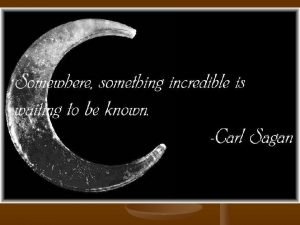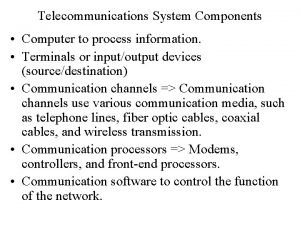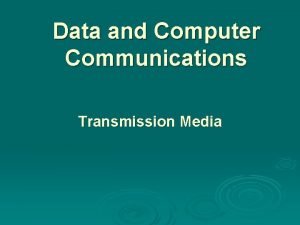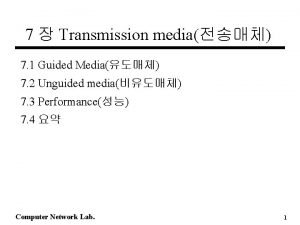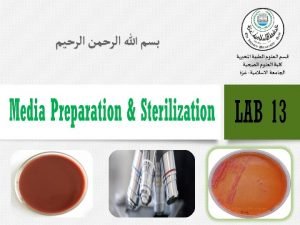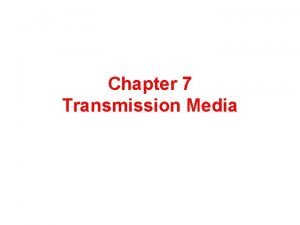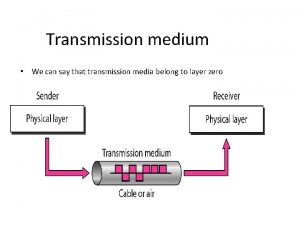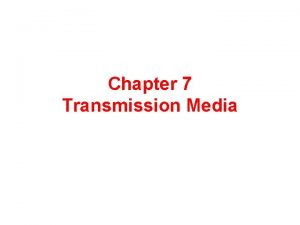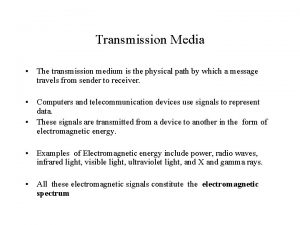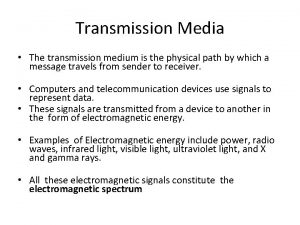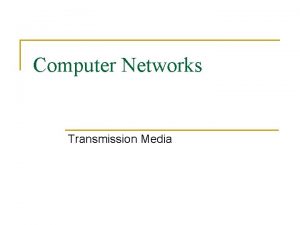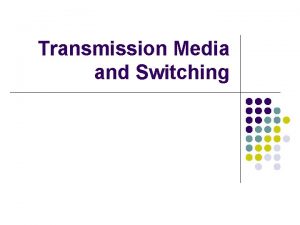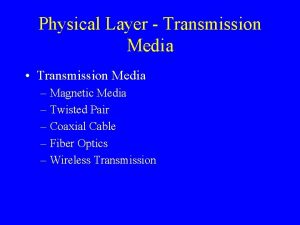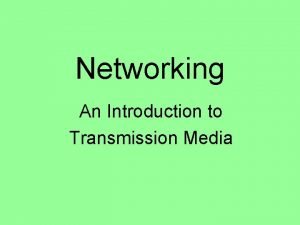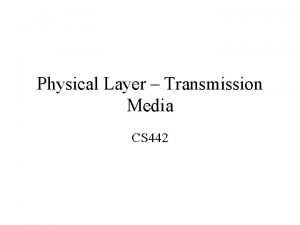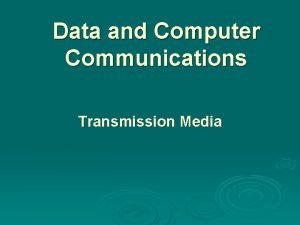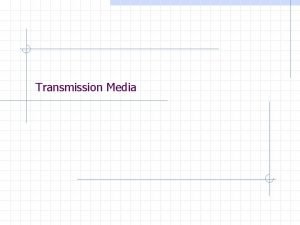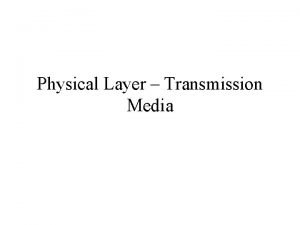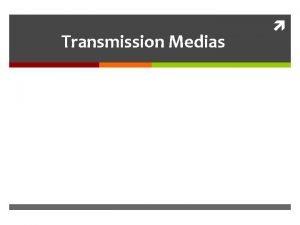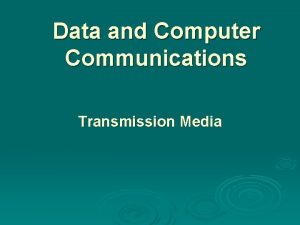Transmission Media Transmission Media The transmission medium is







































- Slides: 39

Transmission Media

Transmission Media The transmission medium is the physical path by which a message travels from sender to receiver. Computers and telecommunication devices use signals to represent data. These signals are transmitted from a device to another in the form of electromagnetic energy. Examples of Electromagnetic energy include power, radio waves, infrared light, ultraviolet light, and X and gamma rays.

Classes of transmission media

Classes of Transmission Media Conducted or guided media n use a conductor such as a wire or a fiber optic cable to move the signal from sender to receiver Wireless or unguided media n use radio waves of different frequencies and do not need a wire or cable conductor to transmit signals

Design Factors for Transmission Media Bandwidth: All other factors remaining constant, the greater the band-width of a signal, the higher the data rate that can be achieved. Transmission impairments. Limit the distance a signal can travel. Interference: signals overlapping frequency bands can distort or wipe out a signal. Number of receivers: Each attachment introduces some, limiting distance and/or data rate.

Guided Transmission Media Transmission capacity depends on the distance and on whether the medium is point-to-point or multipoint Examples n n n twisted pair wires coaxial cables optical fiber

Twisted Pair Wires Consists of two insulated copper wires arranged in a regular spiral pattern to minimize the electromagnetic interference between adjacent pairs Often used at customer facilities and also over distances to carry voice as well as data communications Low frequency transmission medium


Twisted Pair - Applications Most common medium Telephone network n Between house and local exchange (subscriber loop) For local area networks (LAN) n 10 Mbps or 100 Mbps 9

Twisted Pair - Transmission Characteristics Analog n Amplifiers every 5 km to 6 km Digital n repeater every 2 km or 3 km Limited distance Limited bandwidth (1 MHz) Limited data rate (100 MHz) 10

Types of Twisted Pair STP (shielded twisted pair) n the pair is wrapped with metallic foil or braid to insulate the pair from electromagnetic interference UTP (unshielded twisted pair) n each wire is insulated with plastic wrap, but the pair is encased in an outer covering

UTP and STP

Unshielded and Shielded TP Unshielded Twisted Pair (UTP) n n Ordinary telephone wire Cheapest Easiest to install Suffers from external EM interference Shielded Twisted Pair (STP) n n More expensive Harder to handle (thick, heavy) 13

Ratings of Twisted Pair Category 3 UTP n data rates of up to 16 mbps are achievable Category 5 UTP n n n data rates of up to 100 mbps are achievable more tightly twisted than Category 3 cables more expensive, but better performance STP n More expensive, harder to work with

Twisted Pair Advantages Inexpensive Flexible and light weight Easy to work with and install

Twisted Pair Disadvantages defenselessness to interference and noise reduction problem n n For analog, repeaters needed every 5 -6 km For digital, repeaters needed every 2 -3 km Relatively low bandwidth

Coaxial Cable 17

Coaxial Cable Applications Most versatile medium Television distribution n n Ariel to TV Cable TV Long distance telephone transmission n n Can carry 10, 000 voice calls simultaneously Being replaced by fiber optic Short distance computer systems links Local area networks 18

Coaxial Cable - Transmission Characteristics Analog n n Amplifiers every few km Up to 500 MHz Digital n n Repeater every 1 km Closer for higher data rates 19

Coax Layers outer jacket (polyethylene) shield (braided wire) insulating material copper or aluminum conductor

Coax Advantages Higher bandwidth n 400 to 600 Mhz Can be tapped easily (pros and cons) Much less at risk to interference than twisted pair

Fiber Optic Cable Relatively new transmission medium used by telephone companies in place of long-distance trunk lines Also used by private companies in implementing local data communications networks Require a light source with injection laser diode (ILD) or light-emitting diodes (LED)

Optical Fiber - Benefits Greater capacity n Data rates of hundreds of Gbps Smaller size & weight Lower attenuation. Electromagnetic isolation Greater repeater spacing n 10 s of km at least 23

Fiber Optic Layers consists of three concentric sections plastic jacket glass or plastic fiber core cladding

Fiber Optic Advantages greater capacity (bandwidth of up to 2 Gbps) smaller size and lighter weight lower attenuation immunity to environmental interference highly secure due to tap difficulty and lack of signal radiation

Fiber Optic Disadvantages expensive over short distance requires highly skilled installers adding additional nodes is difficult

Wireless (Unguided Media) Transmission transmission and response are achieved by means of an antenna directional n n transmitting antenna puts out focused beam transmitter and receiver must be aligned omnidirectional n n signal spreads out in all directions can be received by many antennas

Wireless Examples terrestrial microwave satellite microwave broadcast radio infrared

Terrestrial Microwave used for long-distance telephone service uses radio frequency spectrum, from 2 to 40 Ghz parabolic dish transmitter, mounted high used by common carriers as well as private networks requires unobstructed line of sight between source and receiver

Satellite Microwave Satellite is relay station Satellite receives on one frequency, amplifies or repeats signal and transmits on another frequency Requires geo-stationary orbit n Height of 35, 784 km Television Long distance telephone Private business networks 30

Satellite Point to Point Link 31

Satellite Broadcast Link 32

Satellite Microwave Applications Television distribution Long-distance telephone transmission Private business networks

Microwave Transmission Disadvantages line of sight requirement expensive towers and repeaters subject to interference such as passing airplanes and rain

Satellite Microwave Transmission a microwave relay station in space can relay signals over long distances geostationary satellites n remain above the equator at a height of 22, 300 miles (geosynchronous orbit)

Satellite Transmission Links earth stations communicate by sending signals to the satellite on an uplink the satellite then repeats those signals on a downlink the broadcast nature of the downlink makes it attractive for services such as the distribution of television programming

Satellite Transmission Process satellite transponder dish 22, 300 miles uplink station downlink station

Radio radio is omnidirectional and microwave is directional Radio is a general term often used to encompass frequencies in the range 3 k. Hz to 300 GHz. Mobile telephony occupies several frequency bands just under 1 GHz.

Infrared Uses transmitters/receivers (transceivers) that modulate noncoherent infrared light. Transceivers must be within line of sight of each other (directly or via reflection ). Unlike microwaves, infrared does not penetrate walls.
 Difference between hot media and cold media
Difference between hot media and cold media Medium medium 35m newton
Medium medium 35m newton Transmission medium
Transmission medium Least expensive transmission media
Least expensive transmission media Transmission media
Transmission media Selective media
Selective media Làm thế nào để 102-1=99
Làm thế nào để 102-1=99 Lời thề hippocrates
Lời thề hippocrates Thang điểm glasgow
Thang điểm glasgow đại từ thay thế
đại từ thay thế Quá trình desamine hóa có thể tạo ra
Quá trình desamine hóa có thể tạo ra Cong thức tính động năng
Cong thức tính động năng Thế nào là mạng điện lắp đặt kiểu nổi
Thế nào là mạng điện lắp đặt kiểu nổi Sự nuôi và dạy con của hổ
Sự nuôi và dạy con của hổ Dot
Dot Nguyên nhân của sự mỏi cơ sinh 8
Nguyên nhân của sự mỏi cơ sinh 8 Bổ thể
Bổ thể Vẽ hình chiếu đứng bằng cạnh của vật thể
Vẽ hình chiếu đứng bằng cạnh của vật thể Phản ứng thế ankan
Phản ứng thế ankan Thiếu nhi thế giới liên hoan
Thiếu nhi thế giới liên hoan Hát lên người ơi alleluia
Hát lên người ơi alleluia điện thế nghỉ
điện thế nghỉ Một số thể thơ truyền thống
Một số thể thơ truyền thống Trời xanh đây là của chúng ta thể thơ
Trời xanh đây là của chúng ta thể thơ Các số nguyên tố
Các số nguyên tố Fecboak
Fecboak đặc điểm cơ thể của người tối cổ
đặc điểm cơ thể của người tối cổ Tỉ lệ cơ thể trẻ em
Tỉ lệ cơ thể trẻ em Các châu lục và đại dương trên thế giới
Các châu lục và đại dương trên thế giới Hệ hô hấp
Hệ hô hấp ưu thế lai là gì
ưu thế lai là gì Môn thể thao bắt đầu bằng chữ f
Môn thể thao bắt đầu bằng chữ f Tư thế ngồi viết
Tư thế ngồi viết Cái miệng bé xinh thế chỉ nói điều hay thôi
Cái miệng bé xinh thế chỉ nói điều hay thôi Hát kết hợp bộ gõ cơ thể
Hát kết hợp bộ gõ cơ thể Cách giải mật thư tọa độ
Cách giải mật thư tọa độ Tư thế ngồi viết
Tư thế ngồi viết Chó sói
Chó sói Thẻ vin
Thẻ vin Ví dụ giọng cùng tên
Ví dụ giọng cùng tên

